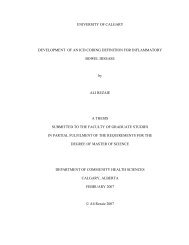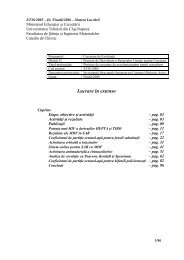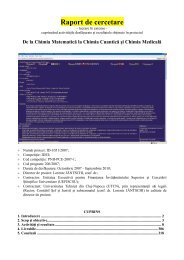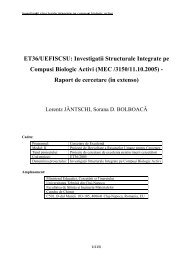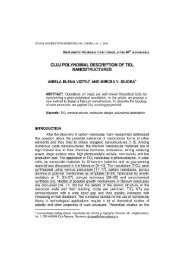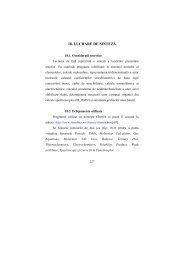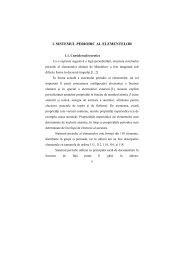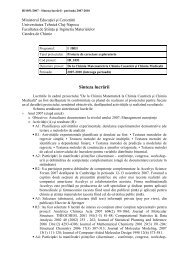Cluj polynomials
Cluj polynomials
Cluj polynomials
Create successful ePaper yourself
Turn your PDF publications into a flip-book with our unique Google optimized e-Paper software.
J Math Chem (2009) 45:295–308<br />
DOI 10.1007/s10910-008-9406-3<br />
ORIGINAL PAPER<br />
<strong>Cluj</strong> <strong>polynomials</strong><br />
Mircea V. Diudea<br />
Published online: 8 August 2008<br />
© Springer Science+Business Media, LLC 2008<br />
Abstract A novel class of counting <strong>polynomials</strong>, called <strong>Cluj</strong> <strong>polynomials</strong> is<br />
proposed on the ground of <strong>Cluj</strong> matrices. The polynomial coefficients are calculated<br />
from the above matrices or by means of orthogonal edge-cuts, in case of distancebased<br />
edge-calculated version. Basic definitions and properties of the <strong>Cluj</strong> matrices<br />
and corresponding <strong>polynomials</strong> are given. Relation with other counting <strong>polynomials</strong><br />
is evidenced. Utility of <strong>Cluj</strong> descriptors in predicting the resonance energy of a set of<br />
planar polyhexes is exemplified.<br />
Keywords <strong>Cluj</strong> matrices · <strong>Cluj</strong> <strong>polynomials</strong> · <strong>Cluj</strong> descriptors ·<br />
Omega polynomial · QSPR<br />
1 Introduction<br />
It is well-known that a graph can be described by: a connection table, a sequence of<br />
numbers, a matrix, a polynomial or a derived number (called a topological index). In<br />
Quantum Chemistry, the early Hűckel theory calculates the levels of π-electron energy,<br />
of the molecular orbitals in conjugated hydrocarbons, as roots of the characteristic<br />
polynomial [1–3]:<br />
P(G, x) = det[xI − A(G)] (1)<br />
M. V. Diudea (B)<br />
Faculty of Chemistry and Chemical Engineering, Babes-Bolyai University,<br />
400028 <strong>Cluj</strong>, Romania<br />
e-mail: diudea@gmail.com<br />
123
296 J Math Chem (2009) 45:295–308<br />
In the above, I is the unit matrix of a pertinent order and A the adjacency matrix of the<br />
graph G. The characteristic polynomial is involved in the evaluation of topological<br />
resonance energy TRE, the topological effect on molecular orbitals TEMO, the aromatic<br />
sextet theory, the Kekulé structure count, etc [1–8].<br />
The coefficients m(G, k) in the polynomial expression:<br />
P(G, x) = <br />
m(G, k) · x k<br />
k<br />
are calculable from the graph G by a method making use of the Sachs graphs, which<br />
are subgraphs of G. Relation (2) was found independently by Sachs, Harary, Milić,<br />
Spialter, Hosoya, etc [2]. The above method is useful in small graphs but, in larger<br />
ones, the numeric methods of linear algebra, such as the recursive algorithms of Le<br />
Verier, Frame, or Fadeev, are more efficient [9,10].<br />
An extension of relation (1) was made by Hosoya et al. [11] and others [12–15]<br />
by changing the adjacency matrix with the distance matrix and next by any square<br />
topological matrix.<br />
Relation (2) is a general expression of a counting polynomial, written as a sequence<br />
of numbers, with the exponents showing the extent of partitions p(G), ∪p(G) =<br />
P(G) of a graph property P(G) while the coefficients m(G, k) are related to the<br />
occurrence of partitions of extent k.<br />
Counting <strong>polynomials</strong> have been introduced, in Mathematical Chemistry literature,byHosoya[16,17]<br />
with his Z-counting (independent edge sets) and the distance<br />
degree (initially called Wiener and later Hosoya) [18,19] <strong>polynomials</strong>. Their roots<br />
and coefficients are used for the characterization of topological nature of hydrocarbons.<br />
Hosoya also proposed the sextet polynomial [20–23] for counting the resonant rings<br />
in a benzenoid molecule. The sextet polynomial is important in connection with the<br />
Clar aromatic sextets [24,25] expected to stabilize the aromatic molecules.<br />
The independence polynomial [26–30] counts selections of k-independent vertices<br />
of G. Other related graph <strong>polynomials</strong> are the king, color and star <strong>polynomials</strong><br />
[31–37].<br />
If instead of sets of independent vertices one counts sets of mutually adjacent vertices,<br />
one obtains the clique polynomial [38–40]. More about <strong>polynomials</strong> the reader<br />
can find in Ref. [2].<br />
In the case of some distance-related properties, the polynomial coefficients are<br />
calculable from the layer and shell matrices [41–45] built up according to the vertex<br />
distance partitions of a graph and calculable by the TOPOCLUJ software package<br />
[46].<br />
The present paper introduces a novel class of counting <strong>polynomials</strong> based on vertex<br />
proximities, as given by the <strong>Cluj</strong> fragments, calculated by the above mentioned<br />
software. The article is organized as follows. Section 2 gives the definitions of <strong>Cluj</strong><br />
matrices and some examples. In Sect. 3, the <strong>Cluj</strong> <strong>polynomials</strong> are introduced while their<br />
properties are discussed, in connection with other counting <strong>polynomials</strong>, in Sect. 4.<br />
In Sect. 5, an example of using descriptors derived from <strong>Cluj</strong> matrices/<strong>polynomials</strong> in<br />
123<br />
(2)
J Math Chem (2009) 45:295–308 297<br />
predicting the resonance energy of some polyhex hydrocarbons is given. Conclusions<br />
and references will close the paper.<br />
2 <strong>Cluj</strong> matrices<br />
A <strong>Cluj</strong> fragment, [2,47–52] symbolized CJi, j,p, collects vertices v lying closer to i<br />
than to j, the endpoints of a path p(i, j). In other words, such a fragment collects the<br />
vertex proximity of i against any vertex j, joined by the path p, with the distances<br />
measured in the subgraph G−p, as shown in the following equation:<br />
CJi, j,p = v v ∈ V (G); D(G−p)(i,v)< D(G−p)( j,v) <br />
(3)<br />
In cycle-containing graphs, more than one path could join the pair (i, j), thus resulting<br />
more than one fragment related to i (with respect to j and a given path p). By<br />
definition, the entries in the <strong>Cluj</strong> matrix are taken as the maximum cardinality among<br />
all such fragments:<br />
[UCJ] i,j = max<br />
p<br />
<br />
CJi, j,p<br />
<br />
(4)<br />
In trees, due to the unicity of paths joining any two vertices, CJi, j,p means the set of<br />
paths going to j through i. In this way, we characterize the path p(i, j) by means of a<br />
single endpoint, that suffices for the unsymmetric matrix UCJ.<br />
When the path p belongs to the set of distances DI(G), the suffix DI is added to<br />
the name of matrix, as UCJDI. When path p belongs to the set of detours DE(G),the<br />
suffix is DE. The <strong>Cluj</strong> matrices are defined in any graph and are, in general, unsymmetric,<br />
excepting some symmetric graphs. They can be symmetrized by the Hadamard<br />
multiplication with their transposes [2,52]<br />
SMp= UM·(UM) T<br />
(5)<br />
SMe= SMp·A (6)<br />
The subscript p means the matrix calculated on paths (i.e., on all pairs of vertices)<br />
while e refers to an edge-calculated (i.e., on all adjacent vertices) matrix. Basic properties<br />
and applications of the above matrices and derived descriptors have been presented<br />
elsewhere [47–51]. Figure 1 and Tables 1–4 give examples of <strong>Cluj</strong> matrices, calculated<br />
on distance and detour, respectively.<br />
3 <strong>Cluj</strong> <strong>polynomials</strong><br />
The <strong>Cluj</strong> <strong>polynomials</strong> are defined, on the basis of <strong>Cluj</strong> matrices, as<br />
CJ(G, x) = <br />
m(G, k) · x k<br />
k<br />
(7)<br />
123
298 J Math Chem (2009) 45:295–308<br />
Fig. 1 Numbering anthracene and phenanthrene molecular graphs<br />
Table 1 UCJDIp(Anthracene A3)<br />
1 2 3 4 5 6 7 8 9 10 11 12 13 14 RS<br />
1 0 11 6 6 2 3 4 4 4 4 6 6 5 5 66<br />
2 3 0 7 2 2 2 4 3 3 3 5 5 4 5 48<br />
3 2 7 0 3 2 2 3 3 3 4 5 4 5 5 48<br />
4 6 6 11 0 3 2 4 4 4 4 5 5 6 6 66<br />
5 10 10 10 11 0 7 6 6 6 7 8 7 7 7 102<br />
6 11 10 10 10 7 0 7 6 6 6 7 7 7 8 102<br />
7 8 8 8 8 4 7 0 7 4 4 8 8 8 8 90<br />
8 8 7 7 7 6 6 7 0 7 6 10 10 10 11 102<br />
9 7 7 7 8 6 6 6 7 0 7 11 10 10 10 102<br />
10 8 8 8 8 7 4 4 4 7 0 8 8 8 8 90<br />
11 6 6 5 5 4 4 4 2 3 4 0 11 6 6 66<br />
12 5 5 4 5 3 3 3 2 2 4 3 0 7 2 48<br />
13 5 4 5 5 3 3 4 2 2 3 2 7 0 3 48<br />
14 5 5 6 6 4 4 4 3 2 4 6 6 11 0 66<br />
CS 84 94 94 84 53 53 60 53 53 60 84 94 94 84 1,044<br />
Table 2 UCJDIe(Anthracene A3)<br />
1 2 3 4 5 6 7 8 9 10 11 12 13 14 RS<br />
1 0 11 0 0 0 3 0 0 0 0 0 0 0 0 14<br />
2 3 0 7 0 0 0 0 0 0 0 0 0 0 0 10<br />
3 0 7 0 3 0 0 0 0 0 0 0 0 0 0 10<br />
4 0 0 11 0 3 0 0 0 0 0 0 0 0 0 14<br />
5 0 0 0 11 0 7 0 0 0 7 0 0 0 0 25<br />
6 11 0 0 0 7 0 7 0 0 0 0 0 0 0 25<br />
7 0 0 0 0 0 7 0 7 0 0 0 0 0 0 14<br />
8 0 0 0 0 0 0 7 0 7 0 0 0 0 11 25<br />
9 0 0 0 0 0 0 0 7 0 7 11 0 0 0 25<br />
10 0 0 0 0 7 0 0 0 7 0 0 0 0 0 14<br />
11 0 0 0 0 0 0 0 0 3 0 0 11 0 0 14<br />
12 0 0 0 0 0 0 0 0 0 0 3 0 7 0 10<br />
13 0 0 0 0 0 0 0 0 0 0 0 7 0 3 10<br />
14 0 0 0 0 0 0 0 3 0 0 0 0 11 0 14<br />
CS 14 18 18 14 17 17 14 17 17 14 14 18 18 14 224<br />
123
J Math Chem (2009) 45:295–308 299<br />
Table 3 UCJDEp(Phenanthrene Ph3)<br />
1 2 3 4 5 6 7 8 9 10 11 12 13 14 RS<br />
1 0 1 1 2 1 1 2 3 3 3 2 2 2 2 25<br />
2 1 0 1 2 2 1 1 2 2 1 1 1 1 1 17<br />
3 1 1 0 3 2 2 3 2 1 1 3 3 3 2 27<br />
4 2 2 3 0 1 1 1 1 6 3 1 2 1 1 25<br />
5 1 2 2 1 0 1 1 1 1 1 2 2 2 2 19<br />
6 1 1 2 1 1 0 3 2 2 2 3 3 3 3 27<br />
7 1 1 1 1 1 2 0 3 3 6 1 1 2 2 25<br />
8 3 2 2 3 3 3 3 0 1 1 2 2 1 1 27<br />
9 2 2 1 4 2 2 1 1 0 1 1 1 2 1 21<br />
10 2 1 1 1 1 1 4 1 1 0 2 2 2 2 21<br />
11 2 2 1 1 2 2 1 2 1 1 0 1 1 2 19<br />
12 3 3 2 3 3 3 1 2 2 2 1 0 1 1 27<br />
13 2 2 3 2 2 2 2 1 3 3 1 1 0 1 25<br />
14 1 1 2 1 1 1 2 1 1 2 2 1 1 0 17<br />
CS 22 21 22 25 22 22 25 22 27 27 22 22 22 21 322<br />
Table 4 UCJDEe(Phenanthrene Ph3)<br />
1 2 3 4 5 6 7 8 9 10 11 12 13 14 RS<br />
1 0 1 0 0 0 1 0 0 0 0 0 0 0 0 2<br />
2 1 0 1 0 0 0 0 0 0 0 0 0 0 0 2<br />
3 0 1 0 3 0 0 0 0 0 1 0 0 0 0 5<br />
4 0 0 3 0 1 0 1 0 0 0 0 0 0 0 5<br />
5 0 0 0 1 0 1 0 0 0 0 0 0 0 0 2<br />
6 1 0 0 0 1 0 0 0 0 0 0 0 0 0 2<br />
7 0 0 0 1 0 0 0 3 0 0 1 0 0 0 5<br />
8 0 0 0 0 0 0 3 0 1 0 0 0 0 1 5<br />
9 0 0 0 0 0 0 0 1 0 1 0 0 0 0 2<br />
10 0 0 1 0 0 0 0 0 1 0 0 0 0 0 2<br />
11 0 0 0 0 0 0 1 0 0 0 0 1 0 0 2<br />
12 0 0 0 0 0 0 0 0 0 0 1 0 1 0 2<br />
13 0 0 0 0 0 0 0 0 0 0 0 1 0 1 2<br />
14 0 0 0 0 0 0 0 1 0 0 0 0 1 0 2<br />
CS 2 2 5 5 2 2 5 5 2 2 2 2 2 2 40<br />
They count vertex proximities of vertices i with respect to any vertex j in G, joined<br />
to i by an edge {pe,i} (the <strong>Cluj</strong>-edge <strong>polynomials</strong>) or by a path {pp,i} (the <strong>Cluj</strong>-path<br />
<strong>polynomials</strong>), taken as the shortest (distance DI) or the longest (detour DE) paths.<br />
In Eq. 7, the coefficients m(G, k) are calculated from the entries of <strong>Cluj</strong> matrices,<br />
as provided by TOPOCLUJ software program [46]. The summation runs up to the<br />
maximum k = |{p}| in G. The above published [42] <strong>Cluj</strong> <strong>polynomials</strong> referred to<br />
some partitions of the <strong>Cluj</strong> matrices given by the layer/shell matrices, with no direct<br />
interpretation of the counting content.<br />
In the case of CJDIe polynomial, an orthogonal edge-cutting procedure can be used,<br />
as suggested in Tables 5 and 6. The same procedure was prior used by Gutman and<br />
Klavžar [53] for calculating the Szeged index of polyhex graphs.<br />
123
300 J Math Chem (2009) 45:295–308<br />
Table 5 Edge cut procedure for calculating <strong>Cluj</strong> polynomial in anthracene A3<br />
CJDIe_i(A3, x)=4x 3 +8x 7 +4x 11 ; D1|x=1=112 CJDIe_ j (A3, x) = 4x 3 + 8x 7 +4x 11 ; D1|x=1=112<br />
CJDIe(A3, x) = 8x 3 + 16x 7 + 8x 11 ; P1|x=1 = 32 = 2e; D1|x=1 = 224<br />
CJDI p(A3, x)=16x 2 +20x 3 +30x 4 + 20x 5 + 28x 6 + 28x 7 + 20x 8 + 12x 10 + 8x 11 ; D1|x=1 = 1044<br />
CJDEe(A3, x) = 28x + 4x 3 ; D1|x=1 = 40<br />
CJDE p(A3, x) = 84x + 60x 2 + 24x 3 + 10x 4 + 4x 6 ; D1|x=1 = 340<br />
Table 6 Edge cut procedure for calculating <strong>Cluj</strong> polynomial in phenanthrene Ph3<br />
CJDIe_i(Ph3, x)=3x 3 +2x 5 +2x 7 +4x 9 + 5x 11 CJDIe_ j (Ph3, x) = 5x 3 + 4x 5 + 2x 7 + 2x9 + 3x 11<br />
D1|x=1 = 124 D1|x=1 = 100<br />
CJDIe(Ph3, x) = 8x 3 + 6x 5 + 4x 7 + 6x 9 + 8x 11 ; P1|x=1 = 32 = 2e; D1|x=1 = 224<br />
CJDI p(Ph3, x)=18x 2 +20x 3 +36x 4 +20x 5 +14x 6 +20x 7 +28x 8 + 6x 9 +12x 10 +8x 11 ; D1|x=1=1050<br />
CJDEe(Ph3, x) = 28x + 4x 3 ; P1|x=1 = 32 = 2e; D1|x=1 = 40<br />
CJDE p(Ph3, x) = 84x + 64x 2 + 30x 3 + 2x 4 + 2x 6 ; D1|x=1 = 322<br />
Since the <strong>Cluj</strong> matrices are unsymmetric, two <strong>polynomials</strong>, one with respect to the<br />
endpoint i (and to the first triangle of UCJDIe) and the other one referring to the<br />
endpoint j of the edge e(i, j) (and to the second triangle of the mentioned matrix)<br />
can be written. However, they depend on the numbering and only their sum polynomial<br />
is invariant (see Tables 5 and 6). This last polynomial will only be taken into<br />
consideration in the following discussion.<br />
4 Properties of the <strong>Cluj</strong> <strong>polynomials</strong><br />
Among the properties of counting <strong>polynomials</strong>, the value in x = 1 and the first derivative<br />
in x = 1 are the most important. In the case of CJDIe polynomial, the value in<br />
x = 1, P|x=1 = 2e. It is evident, since every edge is visited twice.<br />
123
J Math Chem (2009) 45:295–308 301<br />
The first derivative, in x = 1, D1|x=1, gives the meaning of the topological property<br />
collected by a matrix/polynomial. In this case, the following theorem holds:<br />
Theorem 1 In a bipartite graph, the sum of all edge-counted vertex proximities equals<br />
the product v×e of the number of vertices and edges in G.<br />
Demonstration In a bipartite, planar graph, permitting orthogonal edge-cuts, for<br />
every edge e(i, j) ∈ E(G) there is a clear separation of proximities {pe,i} and {pe, j}<br />
of its endpoints. Let’s denote by pe,i and pe, j the cardinalities of the above sets. In a<br />
bipartite graph, we always can write<br />
pe,i + pe, j = v (8)<br />
It follows that, for all edges, e ∈ E(G), the total of edge-counted vertex proximities<br />
pe equals the product v × e, thus demonstrating the theorem.<br />
Recall that an orthogonal (or an elementary) edge-cut of a (polycyclic) bipartite<br />
planar graph G, is a straight line segment, passing through the centers of some edges<br />
of the graph, being orthogonal to these edges, and intersecting the perimeter of G<br />
exactly two times, so that at least one polygon lies between these two intersection<br />
points [2,52,53]. Note that trees also allow elementary edge-cuts.<br />
In the orthogonal edge-cut procedure for calculating the CJDIe index, (i.e., the<br />
sum of all entries in the matrix UCJDIe), the total of edge-counted vertex proximities<br />
pe = CJDIe(G, x)D1|x=1 is calculated as:<br />
pe = <br />
m(G, c) · c · (pe,i + pe, j) = v · <br />
m(G, c) · c = v × e (9)<br />
c<br />
where the coefficients m(G, c) are related to the occurrence of edge-cuts (see below)<br />
of extent c and <br />
c m(G, c) · c = e(G). The above theorem can be extended to 3D<br />
bipartite molecular structures, although the separation of the proximities is not so evident.<br />
Numerical results provided by the <strong>Cluj</strong> matrix support this extension.<br />
Corollary to Theorem 1. In bipartite graphs there are no equidistant vertices with<br />
respect to the two endpoints of any edge.<br />
The <strong>Cluj</strong> matrix counts the vertices lying closer to each of the endpoints of any edge<br />
and leaves the equidistant vertices uncounted. Because of relation (8), it follows that,<br />
in bipartite graphs, all vertices are counted and no equidistant vertices exist. Next, for<br />
all of the edges in G, one obtains the total of vertex proximities, pe, equal to v × e.<br />
This is the main result provided by the <strong>Cluj</strong> matrix/polynomial. The vertex proximity<br />
calculation could be of interest in calculating the bond polarity and molecular dipole<br />
moments. In this respect, weighted molecular graphs must be used.<br />
Recall that, in calculating the Szeged index [53–61] (a topological index related to<br />
the Wiener index, [62] which counts all the shortest distances in a graph), equidistant<br />
vertices are also not counted.<br />
c<br />
123
302 J Math Chem (2009) 45:295–308<br />
Table 7 Formulas for <strong>Cluj</strong>-edge (and related) <strong>polynomials</strong> in acenes Ah; h = no. of hexagons in molecule<br />
CJDIe(Ah−even, x) = 8 · h/2<br />
k=1 x(4k−1) + 2(h + 1) · x (2h+1) + 8<br />
× h k=(h+2)/2 x (4k−1) ; D1|x=1 = 2(2h + 1)(5h + 1) = v · e<br />
CJDIe(Ah−odd, x) = 8 · (h−1)/2<br />
k=1 x (4k−1) + (2(h − 3) + 16) · x (2h+1) + 8<br />
× h k=(h+3)/2 x (4k−1) ; D1|x=1 = v · e<br />
CJDEe(Ah−even, x) = (8h + 4) · x + 4 · h/2<br />
k=2 x(2k−1) + 2 · x (h+1) ; D1|x=1 = h2 + 10h + 2<br />
CJDEe(Ah−odd, x) = (8h + 4) · x + 4 · (h+1)/2<br />
k=2 x (2k−1) ; D1|x=1 = h2 + 10h + 1<br />
(Ah, x) = 2h · x2 + x (h+1) ;|D1|x=1 = e = 5h + 1; D2|x=1 = h(h + 5)<br />
CI(Ah) = ( ′ (Ah)) 2 − ( ′ (Ah) + ′′ (Ah)) = (5h + 1) 2 − (5h + 1 + h(h + 5)) = 24h2 (Ah, x)|x=1 = v/2 = 2h + 1<br />
(Ah, x) = 4h · x (5h−1) + (h + 1) · x4h ; D1|x=1 = 24h2 Table 8 Formulas for <strong>Cluj</strong>-edge (and related) <strong>polynomials</strong> in phenacenes Phh; h = no. of hexagons in<br />
molecule<br />
CJDIe(Phh−even/odd, x)=8 · x3 +4 · h−1 k=2 x(4k−1) +6 · h−1 k=1 x(4k+1) + 8 · x4h−1 ; D1|x=1 = v · e<br />
CJDIe(Ah/Phh) = D1|x=1 = v · e = 2(2h + 1) · (5h + 1) = 2(10h2 + 7h + 1)<br />
CJDEe(Phh−even, x) = (8h + 4) · x + h · x3 + 2 · h/2<br />
k=2 x(4k−1) ; D1|x=1 = h2 + 12h − 2<br />
CJDEe(Phh−odd, x) = (8h + 4) · x + (h + 1) · x3 + 2 · (h−1)/2<br />
k=2 x (4k−1) ; D1|x=1 = h2 + 10h + 1<br />
(Phh, x) = (h + 2) · x2 + (h − 1) · x3 ; D1|x=1 = e = 5h + 1; D2|x=1 = 8h − 2<br />
CI(Phh) = (5h + 1) 2 − (5h + 1 + 8h − 2) = 25h2 − 3h + 2<br />
(Phh, x)|x=1 = v/2 = 2h + 1<br />
(Phh, x) = 2(h + 2) · x (5h−1) + 3(h − 1) · x (5h−2) ; D1|x=1 = 25h2 − 3h + 2<br />
Theorem 2 In a tree graph, the sum of all path-counted vertex proximities is twice<br />
the sum of all distances in G or twice the Wiener W index:<br />
pp = CJDIp(G, x)D1|x=1 = 2W.<br />
Demonstration The column sums in the UCJDIp matrix equals the column sums in<br />
the matrix of distances while the row sums in UCJDIp matrix are identical to those in<br />
the Wiener matrix [2,52]. It is well-known that the half sum of entries in these matrices<br />
counts all the distances in a tree graph, or the Wiener index. Since the first derivative<br />
of the CJDIp polynomial is the sum of all entries in UCJDIp, and this sum is twice<br />
the the Wiener index, the theorem is thus demonstrated.<br />
In cycle-containing graphs, the <strong>Cluj</strong> index CJDIp is different from both the Wiener<br />
and Szeged indices [2,52].<br />
Formulas for calculating the <strong>Cluj</strong> polynomial CJDIe in acenes Ah and phenacenes<br />
Phh, function of the number of their hexagons h, are given in Tables 7 and 8,<br />
respectively.<br />
123
J Math Chem (2009) 45:295–308 303<br />
Theorem 3 A full Hamiltonian graph FH shows the minimal exponent value, 1, and<br />
the minimal value of the first derivatives of <strong>Cluj</strong>-detour <strong>polynomials</strong>:<br />
CJDE p(G, x)D1|x=1 = v(v − 1) and CJDEe(G, x)D1|x=1 = 2e.<br />
Demonstration Recall that a full Hamiltonian FH graph [48] has any pair of its vertices<br />
joined by a Hamiltonian path (i.e., a path visiting all the vertices of G). Considering<br />
that the <strong>Cluj</strong> fragments/proximities are counted by deleting the path p(i, j) excepting<br />
its endpoints, the proximity of i is always 1, vs. any other vertex j in G. Thus,<br />
the exponent takes the minimal (unity) value. The coefficient of this unique term of<br />
CJDEp polynomial is v(v − 1), as counted from the CJDEp matrix (which shows all<br />
its non-diagonal entries equal to unity). For CJDEe, the demonstration is immediate.<br />
Any FH graph shows all the non-diagonal entries in CJDEp matrix equal to unity but<br />
the reciprocal is not always true.<br />
Corollary to Theorem 3. If the FH graph is a complete graph, then: CJDE p(G, x)<br />
D1|x=1.......... = CJDEe(G, x)D1|x=1 = 2e.<br />
In complete graphs, all the vertices are adjacent. Thus, the two <strong>polynomials</strong>, defined<br />
on edges and paths, respectively, coincide, thus v(v − 1) = 2e.<br />
Two related <strong>polynomials</strong> are included in the above tables. One is the Omega polynomial,<br />
[63] (G, x), which counts orthogonal edge-cuts and the second one is the<br />
polynomial (G, x), which is somehow complementary to the above one. It was<br />
shown elsewhere [64,65] that the edges forming an edge-cut strip are locally co-distant,<br />
or equidistant or also “topologically” parallel.<br />
Let m(G, c) denote the occurrence of the edge-cut sequence of length c (i.e., the<br />
number of edges cut-off) in G. In a bipartite, planar graph, the two <strong>polynomials</strong> are<br />
defined as<br />
(G, x) = <br />
m(G, c) · x c<br />
(10)<br />
c<br />
(G, x) = <br />
m(G, c) · c · x (e−c)<br />
c<br />
Their D1|x=1 give the total number of equidistant and non-equidistant edges vs each<br />
edge in G<br />
(11)<br />
(G, x) D1|x=1 = e = |E(G)| (12)<br />
(G, x) D1|x=1 = (G) (13)<br />
where (G) equals (in partial cubes) the Khadikar’s PI topological index [66]. Note<br />
that Ashrafi et al. [67] proposed the PI polynomial PI(G, x), which first derivative<br />
always gives the Khadikar’s PI topological index.<br />
123
304 J Math Chem (2009) 45:295–308<br />
Two indices have been defined on Omega polynomial. The first one, CI, is derived<br />
from the first and second derivatives, in x = 1, as<br />
CI(G) = ((G, x)D1) 2 − ((G, x)D1 + (G, x)D2) |x=1<br />
The second descriptor is calculable from all possible derivatives Dn, inx = 1, and<br />
normalized to the first one (which equals the number of edges in G)<br />
I(G) = (1/(G, x)D1) · <br />
((G, x)Dn) 1/n |x=1 (15)<br />
Theorem 4 In a bipartite planar graph (in a partial cube, in general), CI and PI<br />
indices are identical.<br />
Demonstration From (14) and writing m(G, c) as simply m, CI is calculable as<br />
CI(G) = <br />
{(m · c)<br />
c<br />
2 −[m · c + m · c(c − 1)]}<br />
= <br />
[(m · c) 2 − m · c 2 ]=e 2 − <br />
m · c 2<br />
(16)<br />
c<br />
On the other hand, from (11) and (13), PI is calculated as<br />
PI(G) = <br />
m · c · (e − c) = e <br />
m · c − <br />
m · c 2 = e 2 − <br />
m · c 2<br />
c<br />
c<br />
Clearly, the two indices are identical, because they transform into one and the same<br />
ultimate expression, also proposed by John et al. [68] for calculating PI in benzenoid<br />
hydrocarbon graphs. In the above, the following relation holds<br />
e(G) = <br />
m · c = (G, x)D1|x=1 = (G, x)|x=1 (18)<br />
c<br />
However, relation (11) is not always valid, so that CI is, in general, different from PI,<br />
excepting the case of bipartite planar graphs (partial cubes, in general) [69].<br />
In bipartite graphs embeddable in surfaces of g > 0, e.g., in toroidal polyhexes,<br />
relation (11) is still more hidden, despite CI = PI. In case of the torus T(6,3)H<br />
[8,12]: (G, x) = 12x 4 +4x 24 ; e = 144; CI = 18240; (G, x) = 96x 122 +48x 136 ;<br />
PI = 18240. According to (11) the polynomial would be: (G, x) = 96x 120 +48x 140<br />
that gives the same PI index value. At this moment no generalization of this case was<br />
found.<br />
We stress here that <strong>polynomials</strong> CJDI(G,x) and (G, x) count, in a same manner,<br />
non-equidistant subgraphs (vertices and edges, respectively). An application of these<br />
descriptors is presented below.<br />
123<br />
n<br />
c<br />
c<br />
c<br />
(14)<br />
(17)
J Math Chem (2009) 45:295–308 305<br />
Table 9 Structure of polyhex hydrocarbons<br />
1 2 3<br />
4 5 6<br />
7 8 9<br />
10 11 12<br />
13 14 15<br />
5 Predicting the resonance energy of planar polyhexes<br />
For testing the correlating ability of descriptors derived from <strong>Cluj</strong> and Omega <strong>polynomials</strong>,<br />
a data set of 15 planar polyhex hydrocarbons (Table 9), with at least one<br />
phenanthrenic unit, have been selected from the Randić’s review [70]. The predicted<br />
property was the resonance energy, which is claimed for supporting the aromatic character<br />
of such molecules. Topological descriptors and the corresponding energetic data<br />
are listed in Table 10. The plot of resonance energy vs calculated values (by the best<br />
regression equation (19)) is presented in Fig. 2. The calculations were performed by<br />
the Topo<strong>Cluj</strong> [46] and Omega [71] software packages.<br />
REcalc = 5.02357 − 0.00025 · CJDIp + 0.00489 · CI − 2.68146 · I<br />
n = 15; R2 = 0.984; F = 228.358<br />
6 Conclusions<br />
A novel class of counting <strong>polynomials</strong>, called <strong>Cluj</strong> <strong>polynomials</strong> was proposed on the<br />
ground of previous <strong>Cluj</strong> matrices.<br />
(19)<br />
123
306 J Math Chem (2009) 45:295–308<br />
Table 10 Topological and energetic data for molecules in Table 9<br />
Molecule I CI UCJDIp RE (eV) RE calc.<br />
1 1.498 1,200 11,200 4.085 4.040<br />
2 1.675 1,194 11,237 3.515 3.526<br />
3 1.348 612 4,373 3.209 3.294<br />
4 1.455 610 4,392 3.111 2.993<br />
5 1.455 610 4,290 2.986 3.019<br />
6 1.638 606 4,301 2.531 2.506<br />
7 1.386 390 2,352 2.708 2.619<br />
8 1.558 878 7,350 3.361 3.278<br />
9 1.386 390 2,306 2.506 2.630<br />
10 1.558 878 7,248 3.27 3.304<br />
11 1.523 388 2,303 2.311 2.254<br />
12 1.765 872 7,219 2.671 2.727<br />
13 1.436 218 1,050 1.955 1.973<br />
14 1.455 610 4,318 2.986 3.012<br />
15 1.675 1194 11,404 3.45 3.484<br />
R E (eV)<br />
4.25<br />
3.75<br />
3.25<br />
2.75<br />
2.25<br />
y = 1.0003x - 0.0011<br />
R 2 = 0.984<br />
1.75<br />
1.50 2.00 2.50 3.00<br />
R Ecalc.<br />
3.50 4.00 4.50<br />
Fig. 2 Resonance energy versus calculated values (Eq. 18)<br />
It was shown that the polynomial coefficients are calculable from the above matrices<br />
or by means of orthogonal edge-cuts, in case of CJDIe version.<br />
Basic definitions and properties of the <strong>Cluj</strong> matrices and corresponding <strong>polynomials</strong><br />
were given. The meaning of <strong>Cluj</strong> descriptors, as vertex proximity descriptors, was<br />
clearly evidenced.<br />
It was demonstrated that, in bipartite graphs, the sum of all edge-counted vertex<br />
proximities equals the number v × e, of vertices and edges in the graph. In trees, the<br />
sum of all path-counted vertex proximities is twice the Wiener index.<br />
A full Hamiltonian graph FH was shown to have the minimal exponent value, 1,<br />
and the minimal value of the first derivatives of <strong>Cluj</strong>-detour <strong>polynomials</strong>.<br />
The relation of <strong>Cluj</strong> <strong>polynomials</strong> with the and PI <strong>polynomials</strong> was recognized.<br />
The descriptors derived from the <strong>Cluj</strong> and Omega <strong>polynomials</strong> were used in predicting<br />
the resonance energy of a set of planar polyhexes. The use of vertex proximity<br />
123
J Math Chem (2009) 45:295–308 307<br />
calculation in evaluating the bond polarity and molecular dipole moments was suggested.<br />
Acknowledgement The paper is supported by the CEEX 41Romanian GRANT, 2006.<br />
References<br />
1. M.V. Diudea, O. Ivanciuc, Molecular Topology (in Romanian) (Comprex, <strong>Cluj</strong>, 1995)<br />
2. M.V. Diudea, I. Gutman, L. Jäntschi, Molecular Topology (Nova Science, Huntington, New York,<br />
2001)<br />
3. N. Trinajstić, Chemical Graph Theory, 2nd edn. (CRC Press, New York, 1992)<br />
4. I. Gutman, M. Milun, N. Trinajstić, MATCH, Commun. Math. Comput. Chem. 1, 171–175 (1975)<br />
5. J.Aihara,J.Am.Chem.Soc.98, 2750–2758 (1976)<br />
6. I. Gutman, M. Milun, N. Trinajstić, J. Am. Chem. Soc. 99, 1692–1704 (1977)<br />
7. A. Tang, Y. Kiang, S. Di, G. Yen, Graph Theory and Molecular Orbitals (in Chinese) (Science Press,<br />
Beijing, 1980)<br />
8. A. Tang, Y. Kiang, G. Yan, S. Tai, Graph Theoretical Molecular Orbitals (Science Press, Beijing,<br />
1986)<br />
9. P.S. Dwyes, Linear Computations (Wiley, New York, 1951)<br />
10. D.K. Fadeev, I.S. Sominskii, Problems in Higher Algebra (Freeman, San Francisco, 1965)<br />
11. H. Hosoya, M. Murakami, M. Gotoh, Natl Sci. Rept. Ochanomizu Univ. 24, 27–34 (1973)<br />
12. R.L. Graham, L. Lovasz, Adv. Math. 29, 60–88 (1978)<br />
13. M.V. Diudea, O. Ivanciuc, S. Nikolić, N. Trinajstić, MATCH, Commun. Math. Comput. Chem. 35,<br />
41–64 (1997)<br />
14. O. Ivanciuc, M.V. Diudea, P.V. Khadikar, Indian J. Chem. 37A, 574–585 (1998)<br />
15. O. Ivanciuc, T. Ivanciuc, M.V. Diudea, Roum. Chem. Quart. Rev. 7, 41–67 (1999)<br />
16. H. Hosoya, Bull. Chem. Soc. Japan 44, 2332–2339 (1971)<br />
17. H. Hosoya, Discrete Appl. Math. 19, 239–257 (1988)<br />
18. E.V. Konstantinova, M.V. Diudea, Croat. Chem. Acta, 73, 383–403 (2000)<br />
19. I. Gutman, S. Klavžar, M. Petkovšek, P. Žigert, MATCH,Commun. Math. Chem. 43, 49–66 (2001)<br />
20. H. Hosoya, T. Yamaguchi, Tetrahedron Lett. 4659–4662 (1975)<br />
21. N. Ohkami, H. Hosoya, Theoret. Chim. Acta 64, 153–170 (1983)<br />
22. N. Ohkami, A. Motoyama, T. Yamaguchi, H. Hosoya, Tetrahedron 37, 1113–1122 (1981)<br />
23. H. Hosoya, Topics Curr. Chem. 153, 255–272 (1990)<br />
24. E. Clar, Polycyclic Hydrocarbons (Academic Press, London, 1964)<br />
25. E. Clar, The Aromatic Sextet (Wiley, New York, 1972)<br />
26. I. Gutman, H. Hosoya, Z. Naturforsch 45a, 645–648 (1990)<br />
27. I. Gutman, MATCH, Commun. Math. Chem. 28, 139–150 (1992)<br />
28. I. Gutman, Publ. Inst. Math. (Beograd) 50, 19–23 (1991)<br />
29. I. Gutman, Rev. Roum. Chim. 36, 379–388 (1991)<br />
30. D. Stevanović, Graph Theory Notes New York 34, 31–36 (1998)<br />
31. A. Motoyama, H. Hosoya, J. Math. Phys. 18, 1485–1490 (1977)<br />
32. K. Balasubramanian, R. Ramaraj, J. Comput. Chem. 6, 447–454 (1985)<br />
33. E.J. Farrell, Canad. Math. Bull. 2, 35–46 (1978)<br />
34. E.J. Farrell, C. De Matas, Ark. Math. 26, 185–190 (1988)<br />
35. E.J. Farrell, C. De Matas, Util. Math. 33, 33–45 (1988)<br />
36. E.J. Farrell, C. De Matas, Int. J. Math. Math. Sci. 11, 87–94 (1988)<br />
37. E.J. Farrell, Proc. Caribb. Acad. Sci. 5, 163–168 (1994)<br />
38. E.J. Farrell, Int. J. Math. Math. Sci. 12, 77–84 (1989)<br />
39. C. Hoede, X.L. Li, Discr. Math. 125, 219–228 (1994)<br />
40. D. Stevanović, Publ. Elektrotehn. Fac. (Beograd) Ser. Mat. 8, 84–87 (1997)<br />
41. M.V. Diudea, J. Chem. Inf. Comput. Sci. 34, 1064–1071 (1994)<br />
42. M.V. Diudea, Studia Univ. “Babes-Bolyai” 47, 131–139 (2002)<br />
43. M.V. Diudea, MATCH, Commun. Math. Comput. Chem. 45, 109–122 (2002)<br />
44. M.V. Diudea, O. Ursu, Indian J. Chem. 42A, 1283–1294 (2003)<br />
123
308 J Math Chem (2009) 45:295–308<br />
45. M. Stefu, M.V. Diudea, in: Nanostructures–Novel Architecture, ed. by M. V. Diudea (Nova, New York,<br />
2005), pp. 127–165<br />
46. O. Ursu, M.V. Diudea, TOPOCLUJ software program, Babes-Bolyai University, <strong>Cluj</strong> (2005), http://<br />
chem.ubbcluj/~diudea<br />
47. M.V. Diudea, J. Chem. Inf. Comput. Sci. 37, 300–305 (1997)<br />
48. M.V. Diudea, B. Parv, I. Gutman, J. Chem. Inf. Comput. Sci. 37, 1101–1108 (1997)<br />
49. M.V. Diudea, G. Katona, I. Lukovits, N. Trinajstic, Croat. Chem. Acta 71, 459–471 (1998)<br />
50. L. Jäntschi, G. Katona, M.V. Diudea, MATCH, Commun. Math. Comput. Chem. 41, 151–188 (2000)<br />
51. D. Opris, M.V. Diudea, SAR/QSAR Environ. Res. 12, 159–179 (2001)<br />
52. M.V. Diudea, M.S. Florescu, P. Khadikar, Molecular Topology and it’s Applications (EfiCon Press,<br />
Bucharest, Romania, 2006)<br />
53. I. Gutman, S. Klavžar, J. Chem. Inf. Comput. Sci. 35, 1011–1014 (1995)<br />
54. I. Gutman, Graph Theory Notes of New York 27, 9–15 (1994)<br />
55. A.A. Dobrynin, I. Gutman, Publ. Inst. Math. (Beograd) 56, 18–22 (1994)<br />
56. A.A. Dobrynin, I. Gutman, Graph Theory Notes of New York 2(8), 21–23 (1995)<br />
57. A.A. Dobrynin, I. Gutman, G. Domotor, Appl. Math. Lett. 8, 57–62 (1995)<br />
58. P.V. Khadikar, N.V. Deshpande, P.P. Kale, A. Dobrynin, I. Gutman, G. Domotor, J. Chem. Inf. Comput.<br />
Sci. 35, 547–550 (1995)<br />
59. S. Klavžar, A. Rajapakse, I. Gutman, Appl. Math. Lett. 9, 45–49 (1996)<br />
60. J. Žerovnik, Croat. Chem. Acta 69, 837–843 (1996)<br />
61. A.A. Dobrynin, I. Gutman, Croat. Chem. Acta 69, 845–856 (1996)<br />
62. H. Wiener, Structural determination of paraffin boiling points. J. Am. Chem. Soc. 69, 17–20 (1947)<br />
63. M.V. Diudea, Carpath. J. Math. 22, 43–47 (2006)<br />
64. M.V. Diudea, S. Cigher, A.E. Vizitiu, O. Ursu, P.E. John, Croat. Chem. Acta 79, 445–448 (2006)<br />
65. A.E. Vizitiu, S. Cigher, M.V. Diudea, M.S. Florescu, MATCH Commun. Math. Comput. Chem. 57,<br />
457–462 (2007)<br />
66. P.V. Khadikar, Nat. Acad. Sci. Lett. 23, 113–118 (2000)<br />
67. A.R. Ashrafi, M. Manoochehrian, H. Yousefi Azari, Util. Math. 71, 97–108 (2006)<br />
68. P.E. John, P.V. Khadikar, J. Singh, J. Math. Chem. 42, 37–45 (2007)<br />
69. S. Klavžar, MATCH Commun. Math. Comput. Chem. 59, 217–222 (2008)<br />
70. M. Randić, Chem. Rev. 103, 3449–3605 (2003)<br />
71. S. Cigher, M.V. Diudea, Omega 1.1, software program, “Babes-Bolyai” (University, <strong>Cluj</strong>, Romania,<br />
2005)<br />
123




